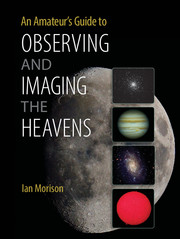Book contents
- Frontmatter
- Dedication
- Contents
- Preface
- Acknowledgements
- Prologue A Tale of Two Scopes
- 1 Telescope and Observing Fundamentals
- 2 Refractors
- 3 Binoculars and Spotting Scopes
- 4 The Newtonian Telescope and Its Derivatives
- 5 The Cassegrain Telescope and Its Derivatives
- 6 Telescope Maintenance, Collimation and Star Testing
- 7 Telescope Accessories
- 8 Telescope Mounts
- 9 The Art of Visual Observing
- 10 Visual Observations of the Moon and Planets
- 11 Imaging the Moon and Planets
- 12 Observing and Imaging the Sun
- 13 Observing and Imaging with an Astro-Video Camera
- 14 DSLR Deep-Sky Imaging
- 15 Imaging with Cooled CCD Cameras
- 16 Auto-Guiding and Drift Scan Alignment
- 17 Spectral Studies
- 18 Improving and Enhancing Images in Photoshop
- Index
- Plate Section
3 - Binoculars and Spotting Scopes
Published online by Cambridge University Press: 05 June 2014
- Frontmatter
- Dedication
- Contents
- Preface
- Acknowledgements
- Prologue A Tale of Two Scopes
- 1 Telescope and Observing Fundamentals
- 2 Refractors
- 3 Binoculars and Spotting Scopes
- 4 The Newtonian Telescope and Its Derivatives
- 5 The Cassegrain Telescope and Its Derivatives
- 6 Telescope Maintenance, Collimation and Star Testing
- 7 Telescope Accessories
- 8 Telescope Mounts
- 9 The Art of Visual Observing
- 10 Visual Observations of the Moon and Planets
- 11 Imaging the Moon and Planets
- 12 Observing and Imaging the Sun
- 13 Observing and Imaging with an Astro-Video Camera
- 14 DSLR Deep-Sky Imaging
- 15 Imaging with Cooled CCD Cameras
- 16 Auto-Guiding and Drift Scan Alignment
- 17 Spectral Studies
- 18 Improving and Enhancing Images in Photoshop
- Index
- Plate Section
Summary
Why Use Binoculars?
In a nutshell, binoculars will give you the best view possible of objects, such as the Andromeda Galaxy and the Pleiades Cluster, that are simply too large to be seen in the field of view of most telescopes and act as a ‘rich-field telescope’ giving wonderful views of the Milky Way (see Figure 3.1). They are usually more compact and weigh less than a telescope system and so can be taken abroad when the luggage allowance precludes a telescope. They are great things to have in any case! The standard parameters of a pair of binoculars are pretty obvious, but there are a few less obvious features that can be quite important, as we will see.
Magnification
This is the first number given in the basic specification of a pair of binoculars. Typical numbers are 8 and 10. One might think that the greater the magnification the better – but this is generally not the case. The greater the magnification, the smaller the field of view will be (as described later) but, perhaps even more important, the more the image will appear to jump about. Unless the binoculars are to be mounted on a tripod or are image stabilized, a magnification greater than 10 is not to be recommended.
- Type
- Chapter
- Information
- An Amateur's Guide to Observing and Imaging the Heavens , pp. 46 - 56Publisher: Cambridge University PressPrint publication year: 2014



